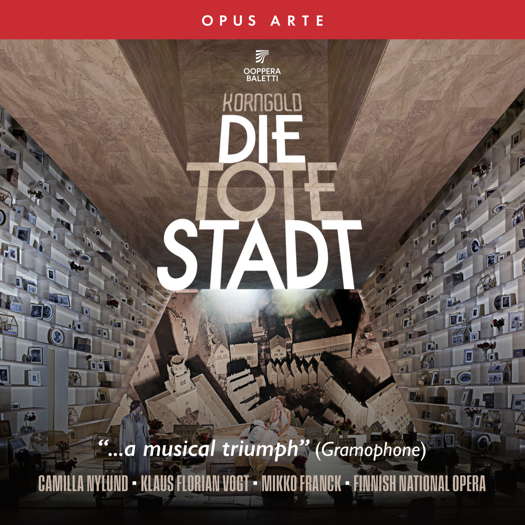- Philadelphia Orchestra
- French Polynesia
- Maria Nockin Chandler
- Bax
- Oskar Sala
- Derby University
- Minato City
- Marcy Stonikas

A Glorious Operatic Triumph
GERALD FENECH listens to Korngold's 'Die tote Stadt'
'... Klaus Florian Vogt and Camilla Nylund rise superbly to the occasion with some searing interpretations worthy of the score.'
Die tote Stadt (The Dead City) is a psychological thriller in three Acts by Erich Wolfgang Korngold (1897-1957). Set to a libretto by Paul Schott, a collective pseudonym for the composer and his father Julius, it is based on the 1892 novel Bruges-la-Morte by George Rodenbach. Die tote Stadt was one of the greatest hits of the 1920s, and within two years of its premiere on 4 December 1920 in Hamburg, it had practically been staged the world over. Korngold started the composition in 1916, but left it for a year to take up military service, before resuming and completing the score. The composer was twenty-three by the time of the Hamburg premiere, but he had already two short one-act operas to his name, Der Ring des Polykrates and Violanta, and the success of these earlier works was so great that Die tote Stadt was subject to a fierce competition among German theatres for the right to the world premiere. In the end, an unusual double premiere was arranged, and the opera opened simultaneously in Hamburg and Cologne. So very tragic, the work was banned by the Nazi regime because of Korngold's Jewish ancestry, and after World War II it fell into obscurity. Thankfully, in recent years, however, the work has enjoyed a notable revival.
So what is so special about this opera? Well, I think everything. Intoxicating melodies, lush orchestration, ingenious harmonies, wonderful characterization and, above all, a story that challenges the human subconsciousness of each individual. Paul could be easily you or I. At this stage I think that it would be very pertinent to share with you the storyline of this extraordinary opera in substantial detail, as this would give a clearer picture of what the work is all about. It seems that Korngold was very satisfied with the reaction to his opera. Indeed, when a new production was rescheduled for Vienna in 1921, the composer wrote a detailed description of the plot for a special issue of Blatter des Opern-theatres, and it is from this literary source that I am sharing with you the dramatic content of this work, albeit in a reduced form.
Listen — Korngold: Behutsam! Hier ist alles alt (Die tote Stadt Act I)
(OACD9050D CD1 track 1, 0:06-0:56) ℗ 2010 Finnish National Opera and Ballet :
The action takes place in Bruges at the end of the nineteenth century and, as the curtain rises, we see Paul mourning the loss of his wife Marie, and the gloomy and decaying city in which he lives is constantly a stark reminder of his loss. In one room of his house he has kept everything that reminds him of her, particularly a portrait and a braid of her golden hair, whose beauty and fragrance he adored. Frank, Paul's friend, has just arrived in Bruges and finds Paul in a state of crisis, after having met a woman whose striking resemblance to Marie has driven him into a state of confusing excitement. Paul cannot resist the impulse to invite her to his house to see her walk through Marie's room, 'to see death return to life'.
This new woman in Paul's life is Marietta, a dancer from Lille who sings a song of 'faithful love that must die'. Paul is struck by this song and his senses are aroused. As she dances, he succumbs to her seduction and tries to embrace her. Pulling away, she becomes entangled in the curtain that covers Marie's portrait, drawing it aside. Paul, stunned, thinks he is seeing Marie alive again. As Marietta leaves for her rehearsals, Paul stays behind, torn by contradicting emotions of loyalty to his beloved Marie and his newly awakened feelings of desire. In this condition of inner turmoil he has a vision. Marie steps from her portrait, an apparition of Paul's conscience and fantasy. He tells her that he has remained loyal to her. Gradually, as the vision fades, he hears Marie telling him: 'Go out in to life, another calls you - see and understand ...' Suddenly he sees Marietta dancing in complete abandon.
Listen — Korngold: Marietta! (Die tote Stadt Act I)
(OACD9050D CD1 track 10, 0:46-1:11) ℗ 2010 Finnish National Opera and Ballet :
In Act II the vision continues. Paul sees himself in front of Marietta's house at night, tormented by his fear and guilt-ridden conscience. He cannot come to terms with the fact that he has fallen victim to the body of a living woman, while searching for the soul of his dead wife. He also sees Brigitte, his old and loyal housekeeper as a novice, who has left him because of his infidelity to Marie. Suddenly, Frank appears in front of Marietta's house. He too has succumbed to the charms of the seductress. As Paul grabs the key to Marietta's house away from him, their friendship is severed. Meanwhile, Marietta arrives with members of her troupe in boats, as Paul withdraws and listens unseen. In a new dream, Marietta is serenaded and appears arm in arm with the dancer Gaston. As everyone is making merry, she suggests a rehearsal of Helene's scene from Meyerbeer's Robert le Diable, the character she is actually singing on stage. Victorin, the stage director, whistles the 'Resurrection' motif from the opera, as an organ sounds from a nearby cathedral, and in the cloister Beguines appear at the windows as ghostly, silent witnesses. As storm clouds gather, bells toll relentlessly. It is as if 'The Dead City' wants to protest.
As Marietta rises from the bench and seductively dances towards Gaston, Paul rushes forward. Marietta's mockery of resurrection outrages him: 'You, a resurrected woman! Never!' he screams. Marietta sends her friends away and remains alone with Paul. He hurls accusations in her face and vents his suppressed emotions. Finally he tells her he only loved his dead wife. Defiant, Marietta takes up the challenge, and draws Paul back to her arms. No longer in control of himself, he surrenders completely to her enticing beauty and both end up in Paul's house. There she wishes to spend the night with him - to banish the ghost forever.
Act III opens with Paul finding Marietta in Marie's room standing before her portrait. It is now morning and the beginning of the day of the holy procession which will pass in front of Paul's house. Marietta is determined to watch everything from this room. The procession proceeds with children in snow-white dresses singing, followed by monks bearing statues and church banners, and the historical group, depicted by leading townspeople dressed in knights' costumes. Finally, the Bishop appears, carrying the golden, holy shrine. Everyone, including Paul, falls to his knees.
Listen — Korngold: Dich such ich, Bild! (Die tote Stadt Act III)
(OACD9050D CD2 track 5, 2:49-3:46) ℗ 2010 Finnish National Opera and Ballet :
At this stage a struggle between good and evil ensues. On the one hand, Marietta tries to use all her seducing powers to make Paul fall for her sensuous snares. On the other, Paul is overcome by his conflict of conscience, but he steadies himself and defends his faith in love and loyalty. In doing so, he provokes Marietta to the very limit, and she explodes in a litany of accusations. For her Paul is a victim of hypocrisy and weakness. He shouts at her to go, but instead she rushes to Marie's portrait and discovers the crystal shrine that contains Marie's hair. Paul tries to take it away from her, at first not succeeding, but after she drapes it around her neck and starts dancing, Paul, enraged, throws her to the floor and strangles her with the braid. He is now surrounded by darkness - the vision has ended.
Slowly it becomes light and Paul awakens. Marietta returns to collect her umbrella and roses, but he remains silent. Seeing that he is not interested in letting her stay, she turns to leave. Just then Frank pops up at the door and bows to her as she walks out. 'Then that was the miracle?' It was the miracle. Paul will not see her again. A dream of bitter reality has destroyed his fantasy. As Paul leaves 'The Dead City' he asks himself: 'How far can mourning for departed ones go without destroying us?' The curtain comes slowly down.
Listen — Korngold: DieTote – wo – lag sie nicht hier (Die tote Stadt Act III)
(OACD9050D CD2 track 11, 10:27-11:23) ℗ 2010 Finnish National Opera and Ballet :
This is an opera full of intense lyrical drama and huge mental torment. Indeed, beneath Paul's hallucinations there is a simmering element that almost consumes him, but which finally helps him to come to terms with grief. Korngold's music is absolutely gorgeous but difficult to sing. Nonetheless, Klaus Florian Vogt and Camilla Nylund rise superbly to the occasion with some searing interpretations worthy of the score. The other soloists also contribute admirably to the cause with some creditable singing of the highest order. Mikko Franck's conducting is just flawless throughout, and his orchestra responds with some lush playing that brings out all the ravishing harmonic beauty of this exceptional creation. A glorious operatic triumph that should grace any collector's musical shelf.
Copyright © 16 April 2022
Gerald Fenech,
Gzira, Malta

CD INFORMATION: DIE TOTE STADT




